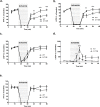Protective Effect of Creatine Elevation against Ischaemia Reperfusion Injury Is Retained in the Presence of Co-Morbidities and during Cardioplegia
- PMID: 26765737
- PMCID: PMC4713158
- DOI: 10.1371/journal.pone.0146429
Protective Effect of Creatine Elevation against Ischaemia Reperfusion Injury Is Retained in the Presence of Co-Morbidities and during Cardioplegia
Abstract
Aims: Ischaemic heart disease is most prevalent in the ageing population and often exists with other comorbidities; however the majority of laboratory research uses young, healthy animal models. Several recent workshops and focus meetings have highlighted the importance of using clinically relevant models to help aid translation to realistic patient populations. We have previously shown that mice over-expressing the creatine transporter (CrT-OE) have elevated intracellular creatine levels and are protected against ischaemia-reperfusion injury. Here we test whether elevating intracellular creatine levels retains a cardioprotective effect in the presence of common comorbidities and whether it is additive to protection afforded by hypothermic cardioplegia.
Methods and results: CrT-OE mice and wild-type controls were subjected to transverse aortic constriction for two weeks to induce compensated left ventricular hypertrophy (LVH). Hearts were retrogradely perfused in Langendorff mode for 15 minutes, followed by 20 minutes ischaemia and 30 minutes reperfusion. CrT-OE hearts exhibited significantly improved functional recovery (Rate pressure product) during reperfusion compared to WT littermates (76% of baseline vs. 59%, respectively, P = 0.02). Aged CrT-OE mouse hearts (78±5 weeks) also had enhanced recovery following 15 minutes ischaemia (104% of baseline vs. 67%, P = 0.0007). The cardioprotective effect of hypothermic high K+ cardioplegic arrest, as used during cardiac surgery and donor heart transplant, was further enhanced in prolonged ischaemia (90 minutes) in CrT-OE Langendorff perfused mouse hearts (76% of baseline vs. 55% of baseline as seen in WT hearts, P = 0.02).
Conclusions: These observations in clinically relevant models further support the development of modulators of intracellular creatine content as a translatable strategy for cardiac protection against ischaemia-reperfusion injury.
Conflict of interest statement
Figures



Similar articles
-
Moderate elevation of intracellular creatine by targeting the creatine transporter protects mice from acute myocardial infarction.Cardiovasc Res. 2012 Dec 1;96(3):466-75. doi: 10.1093/cvr/cvs272. Epub 2012 Aug 21. Cardiovasc Res. 2012. PMID: 22915766 Free PMC article.
-
Over-expression of mitochondrial creatine kinase in the murine heart improves functional recovery and protects against injury following ischaemia-reperfusion.Cardiovasc Res. 2018 May 1;114(6):858-869. doi: 10.1093/cvr/cvy054. Cardiovasc Res. 2018. PMID: 29509881 Free PMC article.
-
Ischaemic postconditioning: does cardioplegia influence protection?Eur J Cardiothorac Surg. 2012 Sep;42(3):530-9. doi: 10.1093/ejcts/ezr305. Epub 2012 Feb 15. Eur J Cardiothorac Surg. 2012. PMID: 22345279
-
Protein kinase C isoform-dependent myocardial protection by ischemic preconditioning and potassium cardioplegia.J Thorac Cardiovasc Surg. 2001 Jan;121(1):137-48. doi: 10.1067/mtc.2001.111210. J Thorac Cardiovasc Surg. 2001. PMID: 11135170
-
Augmentation of Creatine in the Heart.Mini Rev Med Chem. 2016;16(1):19-28. doi: 10.2174/1389557515666150722102151. Mini Rev Med Chem. 2016. PMID: 26202199 Free PMC article. Review.
Cited by
-
Proteomic and metabolomic changes driven by elevating myocardial creatine suggest novel metabolic feedback mechanisms.Amino Acids. 2016 Aug;48(8):1969-81. doi: 10.1007/s00726-016-2236-x. Epub 2016 May 3. Amino Acids. 2016. PMID: 27143170 Free PMC article.
-
Non-invasive investigation of myocardial energetics in cardiac disease using 31P magnetic resonance spectroscopy.Cardiovasc Diagn Ther. 2020 Jun;10(3):625-635. doi: 10.21037/cdt-20-275. Cardiovasc Diagn Ther. 2020. PMID: 32695642 Free PMC article. Review.
-
Superior diastolic function with KATP channel opener diazoxide in a novel mouse Langendorff model.J Surg Res. 2018 Jul;227:186-193. doi: 10.1016/j.jss.2018.02.024. Epub 2018 Mar 22. J Surg Res. 2018. PMID: 29804852 Free PMC article.
-
Creatine Supplementation for Patients with Inflammatory Bowel Diseases: A Scientific Rationale for a Clinical Trial.Nutrients. 2021 Apr 23;13(5):1429. doi: 10.3390/nu13051429. Nutrients. 2021. PMID: 33922654 Free PMC article. Review.
-
Synergistic effect on cardiac energetics by targeting the creatine kinase system: in vivo application of high-resolution 31P-CMRS in the mouse.J Cardiovasc Magn Reson. 2023 Feb 6;25(1):6. doi: 10.1186/s12968-023-00911-6. J Cardiovasc Magn Reson. 2023. PMID: 36740688 Free PMC article.
References
-
- Yellon DM, Hausenloy DJ (2007) Myocardial reperfusion injury. N Engl J Med 357: 1121–1135. - PubMed
-
- Ingwall JS, Weiss RG (2004) Is the failing heart energy starved? On using chemical energy to support cardiac function. Circ Res 95: 135–145. - PubMed
-
- Spindler M, Meyer K, Stromer H, Leupold A, Boehm E, Wagner H, et al. (2004) Creatine kinase-deficient hearts exhibit increased susceptibility to ischemia-reperfusion injury and impaired calcium homeostasis. Am J Physiol Heart Circ Physiol 287: H1039–1045. - PubMed
-
- ten Hove M, Lygate CA, Fischer A, Schneider JE, Sang AE, Hulbert K, et al. (2005) Reduced inotropic reserve and increased susceptibility to cardiac ischemia/reperfusion injury in phosphocreatine-deficient guanidinoacetate-N-methyltransferase-knockout mice. Circulation 111: 2477–2485. - PubMed
-
- Boehm E, Chan S, Monfared M, Wallimann T, Clarke K, Neubauer S (2003) Creatine transporter activity and content in the rat heart supplemented by and depleted of creatine. Am J Physiol Endocrinol Metab 284: E399–406. - PubMed
Publication types
MeSH terms
Substances
Grants and funding
LinkOut - more resources
Full Text Sources
Other Literature Sources
Molecular Biology Databases
Research Materials

